3D-printed wearable BaTiO3/PDMS piezoelectric nanogenerator for self-powered body movement sensing
IF 3.2
4区 工程技术
Q3 MATERIALS SCIENCE, MULTIDISCIPLINARY
引用次数: 0
Abstract
Abstract Flexible piezoelectric nanogenerators used in body movement real-time monitoring are of great interest for their wide application potential such as in the field of smart healthcare. In this work, a self-powered BaTiO3/Polydimethylsiloxane piezoelectric nanogenerator for body movement sensing was successfully fabricated by extrusion 3D printing. Matrix system composed of different ratios of Polydimethylsiloxane was selected based on the rheological property of materials. Experimental investigations were conducted to examine the impact of printing pressure and speed on the linewidth. Subsequently, the extrusion parameters for nanogenerators were determined based on the printed linewidth. The composite showed good ferroelectric property. After polarization, the nanogenerators exhibited an improvement in output performance of up to 55.2%. Additionally, the device demonstrated a good linear relationship between voltage and tapped force test by an electromechanical vibrator. Successful detection of body or muscle movement signals was achieved when the nanogenerator was mounted on the human finger, throat, or foot using a wearable sock, highlighting its potential for applications in self-powered wearable devices for smart healthcare.3d打印可穿戴式BaTiO3/PDMS压电纳米发电机,用于自供电身体运动传感
柔性压电纳米发电机因其在智能医疗等领域的广泛应用潜力,在人体运动实时监测中备受关注。在这项工作中,通过挤压3D打印成功地制造了用于身体运动传感的自供电BaTiO3/聚二甲基硅氧烷压电纳米发电机。根据材料的流变性能,选择由不同配比的聚二甲基硅氧烷组成的基体体系。实验研究了印刷压力和印刷速度对线宽的影响。然后,根据打印线宽确定了纳米发电机的挤压参数。该复合材料具有良好的铁电性能。极化后,纳米发电机的输出性能提高了55.2%。此外,该装置还通过机电振动器测试了电压与抽头力之间良好的线性关系。当使用可穿戴袜子将纳米发电机安装在人的手指、喉咙或脚上时,可以成功检测身体或肌肉运动信号,这突出了其在智能医疗的自供电可穿戴设备中的应用潜力。
本文章由计算机程序翻译,如有差异,请以英文原文为准。
求助全文
约1分钟内获得全文
求助全文
来源期刊

Flexible and Printed Electronics
MATERIALS SCIENCE, MULTIDISCIPLINARY-
CiteScore
4.80
自引率
9.70%
发文量
101
期刊介绍:
Flexible and Printed Electronics is a multidisciplinary journal publishing cutting edge research articles on electronics that can be either flexible, plastic, stretchable, conformable or printed. Research related to electronic materials, manufacturing techniques, components or systems which meets any one (or more) of the above criteria is suitable for publication in the journal. Subjects included in the journal range from flexible materials and printing techniques, design or modelling of electrical systems and components, advanced fabrication methods and bioelectronics, to the properties of devices and end user applications.
 求助内容:
求助内容: 应助结果提醒方式:
应助结果提醒方式:


